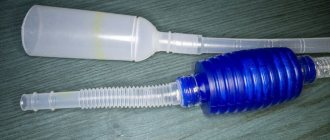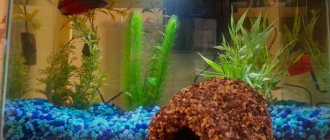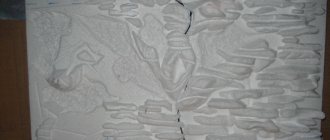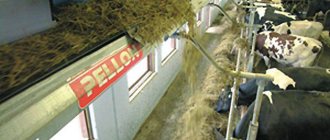Why do you need a biofilter?
The enclosed space of an aquarium requires human participation in replacing water, which over time becomes unsuitable for life. For this purpose, biofilters are installed, the main function of which is to oxidize ammonia formed due to the decomposition of uneaten food, fish metabolic products, and the work of harmful microorganisms. The filter creates a nitrogen cycle in the aquarium, during which ammonia is converted into nitrite, nitrite into safe nitrate. In the absence of harmful substances, the inhabitants of the aquarium get sick less, and the risk of water “blooming” is reduced.
What does it consist of and how does it work?
The design of the cleaning system depends on the volume of the aquarium. The larger it is, the more complex the system is. Bulky filters include auxiliary compartments for multi-level cleaning and devices for controlling water supply.
The purification system is an open or closed container with a volume of 2 to 7 (or more) liters, filled with fillers for biofilters. For ease of maintenance, the container is divided into chambers, which are filled with cleaning materials for various purposes. Sometimes the compartments are replaced by special mesh baskets located one above the other.
A simple biofilter consists of a tube that sprays water, a compressor that supplies air to the baking powder, filter material, seals, and adapters. Depending on the manufacturer, modular and one-piece installations may be available.
Simple biofilter from a tube
Principle of operation:
The purifier body is immersed in the aquarium, where dirty water enters it. Filtration from impurities occurs. Afterwards, the filler begins to work, in which microorganisms that neutralize ammonia accumulate. The purified water goes into the sprayer, where it is saturated with oxygen and returned to the aquarium.
Other models
In addition to external filters, there are other filters for aquariums.
Airlift
Such devices purify water using air. They are gradually losing their popularity due to low efficiency. Inexpensive, they can be made at home. You can make an air filter from a plastic tube. At the upper end there is a square that supplies water. A hose is inserted at the bottom of the tube, on which a sponge is placed.
Mounted
For a small aquarium, you can make a hanging filter with your own hands. A glass or plastic container in which partitions are made is suitable for manufacturing. The first compartment contains padding polyester, the remaining compartments are filled with filter media. Water is supplied by a compressor.
Carbonic
Purifies water chemically, destroying foreign odors and cloudiness. Along the way, useful substances disappear, so constant use is undesirable. This type of device is made independently from metal mesh. Two cylinders of different diameters are made, and plugs are attached to the bottom. The smaller cylinder is placed inside the larger one, the structure is fixed with a self-tapping screw. Coarse coal is poured in, and a padding polyester prefilter is placed on top.
The procedure for placing fillers in an aquarium filter
High-quality cleaning of the aquarium is achieved using multi-level filtration. The sequence of installation depends on the type and combination of fillers.
There should always be a pre-filter at the base, which thoroughly cleans the water from large dirt and guarantees protection of the filter system from clogging with large debris. To do this, use a coarse-grained sponge, which should be located in the first compartment in the direction of flow or on the intake pipe.
The second element is a foam sponge, which serves for basic mechanical filtration.
Advice! It is recommended to use synthetic padding polyester as the third component to complete mechanical cleaning. It absorbs the smallest contaminants, so it quickly becomes clogged, which can interrupt the operation of the entire system. The service life depends on the quality of work of the previous components.
Coarse sponge
The fourth element is a material intended for chemical cleaning - activated carbon, zeolite.
Next comes the filler that performs biological filtration - bioballs, sintered glass, ceramic rings for the aquarium.
The sixth component is optional and is used to add additional properties to the water. The most commonly used material is peat. When water is passed through it, the acidity of the medium increases and the hardness index decreases.
It is not necessary to follow the same order of laying materials. Each aquarium owner uses what he considers most suitable for his case. By experimenting with different combinations, you can choose the ideal installation method for each aquarium.
How to care
It is necessary to carefully monitor the operation of the equipment: filtration occurs without interruptions and leaks. As pollution occurs, the power decreases and the water pressure weakens. Filter sponges are periodically checked and replaced with new ones when worn out.
Cleaning
The filter device must be washed with water taken from the aquarium to prevent disturbance of the bacterial environment. The filler is washed with extreme care. Thorough rinsing is detrimental to beneficial bacteria.
A complete flush is carried out every six months.
Types of filter materials
Depending on the operating principle, there are three types of filtration: mechanical, chemical, biological.
Mechanical cleaning is aimed at removing plant particles, fish waste, and food residues. This process is mandatory for any aquarium and must occur around the clock. Cleaning substrates must be flushed regularly to avoid clogging and reduced productivity of the material.
Chemical cleaning is used to remove toxins, medications, and heavy metals from the environment that enter the aquarium with drinking water or medications and are harmful to both fish and plants. Chemical filtration is carried out using ceramic aquarium rings, which, due to their composition, carry out a chemical reaction by absorbing phosphates.
A biological filter for an aquarium is installed in a specially designated sector inhabited by colonies of useful microelements. They feed on a variety of biological debris; the dirtier the water, the better it is filtered. The specificity of the section is its spongy structure, due to which the area of contact with water increases.
Activated carbon
Externally it resembles black granules. The principle of operation resembles a sponge and is characterized by good absorption ability. Neutralizes liquid coloring chemically, absorbs heavy metals, ozone, chlorine. Does not react to snails, algae, or medications.
Activated carbon for aquarium
This filter cannot be used on a permanent basis. Having saturated to a certain extent, it begins to throw everything in organic matter back into the water, which is unfavorable for the inhabitants of the aquarium. In addition, it does not filter ammonia and can absorb bacteria beneficial to plants.
Suitable for use with other filters in case of heavy water contamination or the need for purification after prolonged use of medications. Used in a proportion of 1 g per 10 liters, valid for 14 days.
Ceramics
Made in the form of small hollow tubes, it has a spongy structure. The ceramic porous filler acts as a catalyst for the emergence of many nitrifying microorganisms necessary for the correct nitrogen cycle and the establishment of biological balance. The purifier has a number of positive characteristics - it sprays oxygen well, because of the holes, water is evenly distributed throughout the entire aquarium, and does not require rinsing.
Sintepon
This type is made from durable material with a special composition, which provides the highest quality filtration. The filler captures the smallest particles, dust, and turbidity that form after cleaning the soil in the aquarium.
The disadvantage of this filler is rapid wear. After a few weeks of operation, it becomes clogged with filtered particles and turns into a lump of dirt. To prolong the work, you can rinse with running water, which is ineffective.
Ceramic rings for aquarium
Sintepon
Important! Syntrepon is an essential component of multi-stage cleaners with highly productive pumps, which are used for high-speed cleaning of large-volume containers.
Zeolite
A budget-friendly and effective natural method of volcanic and siege origin. Quickly absorbs ammonium, ammonia and other toxic substances in water. Absorbs dyes, medications, heavy metals. Acts as a stabilizer of nutrients and soil accumulators.
The disadvantage of the filler is the ability to oxidize water during prolonged use. The concentration of phosphates and the relative constancy of the ratio of acids and bases in water decreases.
Peat
Used since ancient times, peat is one of the most common and inexpensive fillers.
Contains a complex of decayed fossil substances of natural origin. Rich in humic substances, organic products, tanning materials, waxes, salts, resins, etc.
Advantages:
- does not allow bacteria and fungi to multiply;
- stimulates the growth of aquatic plants, in particular roots;
- reduces water hardness;
- regulates the acidity of the environment.
Peat has disadvantages that limit its use. The material cannot be used without first examining the water parameters. If the level of acidity and hardness is low, the filler will have to be discarded.
Zeolite
Peat
It is recommended to choose an alternative if the inhabitants of the aquarium suffer from increased levels of bases in the body. An aesthetic problem - peat gives the water a brownish tint.
The filler is characterized by a ratio of 100 g per 10 liters. It will be necessary to monitor the density of the material; if it is insufficient, the flow of liquid increases and does not have time to become rich; if it is in excess, it interferes with the flow of water. The validity period of the filler is from 3 to 6 months.
Modern products are made from two-component peat of varying degrees of acidity to gradually soften the water in the aquarium.
Expanded clay
The filter is of natural origin and looks like a ball. The element can be found on the construction market. The filler can be collected in nature; additional processing will be required before use, since the composition may contain silicates, heavy metals, and phosphates. The balls are washed through a sieve, boiled for half an hour, laid out on a baking sheet and fried at a temperature of 180°C.
The porous surface of the filler is inhabited by bacteria that participate in the nitrogen cycle. Expanded clay copes well with biological filtration and absorbs large dirt and debris.
Expanded clay
Sponge
A mandatory component of the system is a sponge filter for the aquarium. The optimal choice is a material with a high structure - it absorbs mechanical compounds better.
Aquarists use specially produced sponges that are used in external and internal filters.
Sintered glass
Glass is made using a special technique, which results in the formation of a loose substance that favors the settlement of microorganisms. The filler can be given any shape; it is most effective in the form of balls with a diameter of 8-14 mm. The material copes well with the processing of nitrates, the breakdown of ammonium and nitrites.
If you wash the glass occasionally with running water, the service life will be about six months.
Sponge filter for aquarium
Sintered glass
Bioballs
Plastic balls with an uneven surface are used in combination with other fillers. Thanks to their shape, they move through water flows, break them up, facilitating the measured washing of other filter materials.
Despite their structure, which is favorable for the life of bacteria, when used independently, bioballs have almost no effect.
Gravel
Used in filters with a mechanical design. Biorefiners will require the same size material. Like expanded clay, you can get it yourself; it will require roasting in the oven before use.
Bioballs
Gravel
Purpose of the external filter
An aquarium filter is a mandatory attribute of modern pet fish abodes. Life in an aquarium without a filter is only possible if there are a large number of living plants in it.
The main tasks of the filter are the mechanical purification of water, the removal of waste products from the inhabitants of the aquarium, as well as the movement of water masses and their saturation with oxygen. Provided the device is correctly selected and installed, the lower and upper layers of water will constantly move, which helps improve gas exchange between the aquarium water and the surrounding air.
DIY external filter
At the same time, the upper layer of water releases carbon dioxide and sinks down - this ensures that the fish will not accumulate on the surface of the water, but will be distributed more or less evenly throughout its entire volume.
Aquarium filters are available both internal and external. The latter, due to the possibility of increasing their volume, often have greater power and can be installed on aquariums of impressive size. Among aquarists, this model of filter device is often called a bucket.
The undeniable advantages of an external filter over its internally installed counterpart are:
- higher quality filtration;
- ease of cleaning and maintenance;
- the possibility of providing several stages of purification (mechanical, biological), as well as the possibility of softening water through additional additives.
Among the disadvantages of the devices under consideration, we can note the high cost and the need for space for its installation.
Popular brands of biofilters
Tetra ex
This German company is known for the quality of its products. It produces equipment capable of cleaning an aquarium with a volume of 60-500 liters. Biological balls and ceramic rings are used as filter materials.
Each product is accompanied by detailed instructions. Before assembly, it is necessary to wash the parts from dust. To start the equipment, use the pumping button, which is located on the body, creating a flow draft.
Note! It is advisable to have a tetra repair kit for tetra aps compressors in stock, in case the main compressor breaks down.
Jbl
Company from Germany. Manufactures filters that are beneficial for use. Their products use bioceramics. Water is supplied from above, passes through mechanical filter materials, and returns through biological matter.
Launched using the same method as Tetra.
Aquel
Polish manufacturer. Prices for its products are lower, which does not affect quality and reliability. The equipment is intended for aquariums with volumes of 100-700 liters. Large installations use two pumps and four hoses to create a strong flow and mix the water. Ceramic rings are used as filter material.
Biofilter Tetra ex
Biofilter Jbl
Biofilter Aquel
Advantages and disadvantages
Such devices have many advantages. The best internal filters for an aquarium usually differ in the following criteria:
- Availability. They will cost at least half the price of an external device with approximately the same performance.
- Complete security. The possibility of leaks is eliminated, because the filter is located inside.
- Reliability. Only the pump can fail, but as practice shows, the devices are capable of operating without interruption for the entire period stated by the manufacturer.
- Service. Regular cleaning of the filter material does not take much time. In a couple of minutes you can remove the sponge and simply wash it in water. At this point the procedure is considered complete.
- Bandwidth. It depends on the specific model and can reach more than two thousand liters per hour. Due to this, you can be sure of excellent water circulation in the tank.
- Energy consumption. Aquarists highlight the high energy efficiency of such compact devices.
- Silence. Large external filters can produce vibrations and hum, but here complete silence is achieved.
Do-it-yourself biofilter for an aquarium
If you follow the instructions carefully, you can make the filter yourself. It will work no worse than products from well-known manufacturers.
Bowl in a glass
Materials:
- plastic bottle;
- PVC pipe with a diameter of different neck sizes;
- pebbles with a fraction of up to 5 mm;
- compressor;
- padding polyester
It is necessary to cut the bottle so that the top part hardly fits into the bottom. 10 holes are made in the element with a neck, 3-4 mm in diameter. Insert the tube there, make sure that it does not reach the bottom and fits tightly, otherwise seal it with silicone glue. Pour 5-6 cm of pebbles into the finished structure and place padding polyester on top. All that remains is to place the hose from the compressor into the tube and check the filter for functionality.
The robot principle is based on air circulation. The mixture is enriched with oxygen, water flows to the bottom of the tube and enters the aquarium.
Biofilter using Bowl in a glass technology
Bottle filter
Materials:
- plastic bottle 1.5 l;
- clamp;
- substrate;
- foam;
- hose;
- spray;
- compressor.
Using an awl, holes are made at the bottom of the bottle, after which it needs to be wrapped with foam rubber and tightened with a clamp. Fill half the container with a nutrient mixture for microorganisms. Route the compressor hose to the sprayer.
The size of the bottle is selected in proportion to the size of the aquarium and the performance of the compressor. Oxygen creates a current, air and water are forced out through the neck. Liquid enters through the holes at the bottom. Microorganisms appear in the filter materials and absorb toxic elements.
Biofilter from a bottle
Glass barriers
Differs in complexity of manufacture, better quality than analogues.
Materials:
- aquarium glue;
- glass;
- glass cutter;
- three types of filter materials;
- ruler;
- centimeter;
- alcohol;
- matches.
Before construction, accurate measurements of the length and width of the aquarium are taken. Based on their results, glass is made that will be the bottom of the future filter, two side and rear walls with a length equal to that of an aquarium and a height of up to 10 cm. All parts are cleaned with alcohol and covered with glue along the edges.
While the composition hardens, you need to make partitions that should be slightly lower than the walls; it is necessary that water in this place passes along the bottom.
Note! It is recommended to use a matchbox to adjust the height. The barrier is fixed, and next to it, close to the bottom, a second one is attached.
The third is installed at an equal interval from the first. After 24 hours, the matchbox can be removed from under one barrier. Two more partitions are attached to the free side of the structure where water will flow.
Two strips are cut out, one along the length of the filter, 2 cm wide, the second slightly shorter than the length of the aquarium, 7 cm high. The first strip is attached to the end part of the second barrier like a visor, the second is installed in the third sector, where padding polyester is added. The barrier is fixed, another 2 cm wide strip is installed under the gap, as long as a partition for the filler.
All that remains is to fill the compartments. The first is foam rubber, the second is aquarium ceramics or expanded clay, the third is padding polyester. The purifier is mounted above the aquarium, and a hose is led from the pump to check the design for functionality.
Glass barriers
A filter is a necessary device in an aquarium. It simplifies care, reduces the frequency of algal “epidemics” and fish diseases, and supports microflora. There are three types of filtration: biological, chemical and mechanical. For the system to operate correctly, you will need several types of cleaning materials. A functional, high-quality filter can be easily built from scrap materials, such as a plastic bottle and a compressor. If desired, you can build a more complex model of the purifier in the form of glass barriers. Its construction takes more time, but is compensated by the fun of the process.
Was this information useful to you? Share in the comments!










